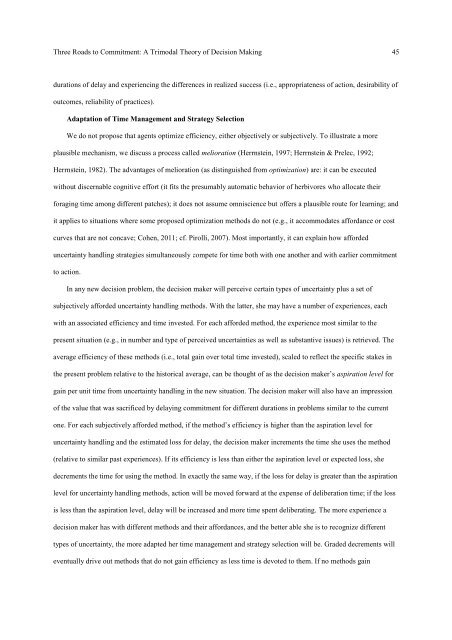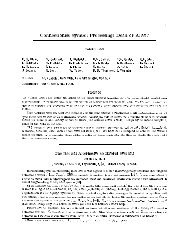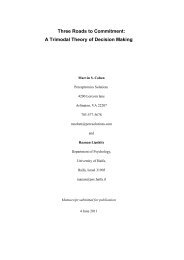Three Roads to Commitment: A Trimodal Theory of Decision Making
Three Roads to Commitment: A Trimodal Theory of Decision Making
Three Roads to Commitment: A Trimodal Theory of Decision Making
You also want an ePaper? Increase the reach of your titles
YUMPU automatically turns print PDFs into web optimized ePapers that Google loves.
<strong>Three</strong> <strong>Roads</strong> <strong>to</strong> <strong>Commitment</strong>: A <strong>Trimodal</strong> <strong>Theory</strong> <strong>of</strong> <strong>Decision</strong> <strong>Making</strong> 45<br />
durations <strong>of</strong> delay and experiencing the differences in realized success (i.e., appropriateness <strong>of</strong> action, desirability <strong>of</strong><br />
outcomes, reliability <strong>of</strong> practices).<br />
Adaptation <strong>of</strong> Time Management and Strategy Selection<br />
We do not propose that agents optimize efficiency, either objectively or subjectively. To illustrate a more<br />
plausible mechanism, we discuss a process called melioration (Herrnstein, 1997; Herrnstein & Prelec, 1992;<br />
Herrnstein, 1982). The advantages <strong>of</strong> melioration (as distinguished from optimization) are: it can be executed<br />
without discernable cognitive effort (it fits the presumably au<strong>to</strong>matic behavior <strong>of</strong> herbivores who allocate their<br />
foraging time among different patches); it does not assume omniscience but <strong>of</strong>fers a plausible route for learning; and<br />
it applies <strong>to</strong> situations where some proposed optimization methods do not (e.g., it accommodates affordance or cost<br />
curves that are not concave; Cohen, 2011; cf. Pirolli, 2007). Most importantly, it can explain how afforded<br />
uncertainty handling strategies simultaneously compete for time both with one another and with earlier commitment<br />
<strong>to</strong> action.<br />
In any new decision problem, the decision maker will perceive certain types <strong>of</strong> uncertainty plus a set <strong>of</strong><br />
subjectively afforded uncertainty handling methods. With the latter, she may have a number <strong>of</strong> experiences, each<br />
with an associated efficiency and time invested. For each afforded method, the experience most similar <strong>to</strong> the<br />
present situation (e.g., in number and type <strong>of</strong> perceived uncertainties as well as substantive issues) is retrieved. The<br />
average efficiency <strong>of</strong> these methods (i.e., <strong>to</strong>tal gain over <strong>to</strong>tal time invested), scaled <strong>to</strong> reflect the specific stakes in<br />
the present problem relative <strong>to</strong> the his<strong>to</strong>rical average, can be thought <strong>of</strong> as the decision maker’s aspiration level for<br />
gain per unit time from uncertainty handling in the new situation. The decision maker will also have an impression<br />
<strong>of</strong> the value that was sacrificed by delaying commitment for different durations in problems similar <strong>to</strong> the current<br />
one. For each subjectively afforded method, if the method’s efficiency is higher than the aspiration level for<br />
uncertainty handling and the estimated loss for delay, the decision maker increments the time she uses the method<br />
(relative <strong>to</strong> similar past experiences). If its efficiency is less than either the aspiration level or expected loss, she<br />
decrements the time for using the method. In exactly the same way, if the loss for delay is greater than the aspiration<br />
level for uncertainty handling methods, action will be moved forward at the expense <strong>of</strong> deliberation time; if the loss<br />
is less than the aspiration level, delay will be increased and more time spent deliberating. The more experience a<br />
decision maker has with different methods and their affordances, and the better able she is <strong>to</strong> recognize different<br />
types <strong>of</strong> uncertainty, the more adapted her time management and strategy selection will be. Graded decrements will<br />
eventually drive out methods that do not gain efficiency as less time is devoted <strong>to</strong> them. If no methods gain




